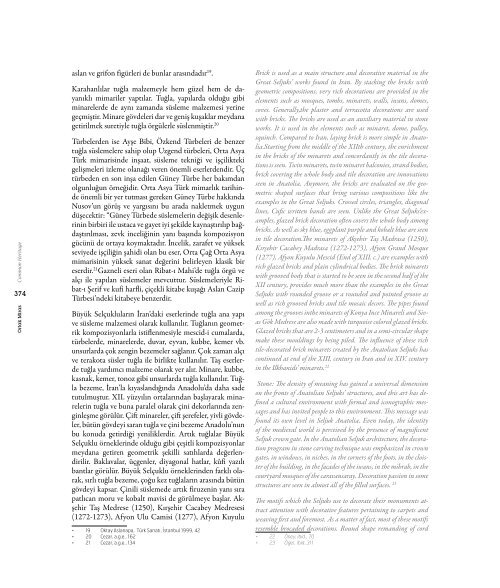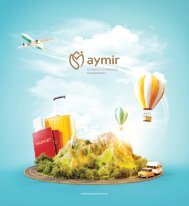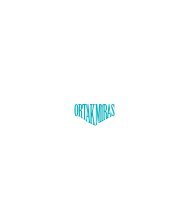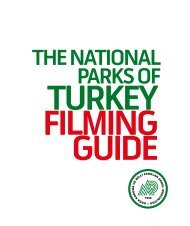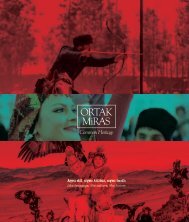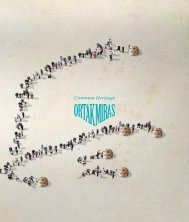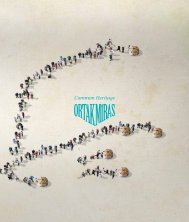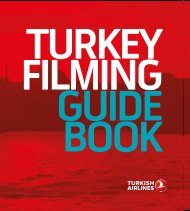You also want an ePaper? Increase the reach of your titles
YUMPU automatically turns print PDFs into web optimized ePapers that Google loves.
Common Heritage<br />
374<br />
Ortak Miras<br />
aslan ve grifon figürleri de bunlar arasındadır 19 .<br />
Karahanlılar tuğla malzemeyle hem güzel hem de dayanıklı<br />
mimariler yaptılar. Tuğla, yapılarda olduğu gibi<br />
minarelerde de aynı zamanda süsleme malzemesi yerine<br />
geçmiştir. Minare gövdeleri dar ve geniş kuşaklar meydana<br />
getirilmek suretiyle tuğla örgülerle süslenmiştir. 20<br />
Türbelerden ise Ayşe Bibi, Özkend Türbeleri de benzer<br />
tuğla süslemelere sahip olup Uzgend türbeleri, Orta Asya<br />
Türk mimarisinde inşaat, süsleme tekniği ve işçilikteki<br />
gelişmeleri izleme olanağı veren önemli eserlerdendir. Üç<br />
türbeden en son inşa edilen Güney Türbe her bakımdan<br />
olgunluğun örneğidir. Orta Asya Türk mimarlık tarihinde<br />
önemli bir yer tutması gereken Güney Türbe hakkında<br />
Nusov’un görüş ve yargısını bu arada nakletmek uygun<br />
düşecektir: “Güney Türbede süslemelerin değişik desenlerinin<br />
birbiri ile ustaca ve gayet iyi şekilde kaynaştırılıp bağdaştırılması,<br />
zevk inceliğinin yanı başında kompozisyon<br />
gücünü de ortaya koymaktadır. İncelik, zarafet ve yüksek<br />
seviyede işçiliğin şahidi olan bu eser, Orta Çağ Orta Asya<br />
mimarisinin yüksek sanat değerini belirleyen klasik bir<br />
eserdir. 21 Gazneli eseri olan Ribat-ı Mahi’de tuğla örgü ve<br />
alçı ile yapılan süslemeler mevcuttur. Süslemeleriyle Ribat-ı<br />
Şerif ve kufi harfli, çiçekli kitabe kuşağı Aslan Cazip<br />
Türbesi’ndeki kitabeye benzerdir.<br />
Büyük Selçukluların İran’daki eserlerinde tuğla ana yapı<br />
ve süsleme malzemesi olarak kullanılır. Tuğlanın geometrik<br />
kompozisyonlarla istiflenmesiyle mescid-i cumalarda,<br />
türbelerde, minarelerde, duvar, eyvan, kubbe, kemer vb.<br />
unsurlarda çok zengin bezemeler sağlanır. Çok zaman alçı<br />
ve terakota süsler tuğla ile birlikte kullanılır. Taş eserlerde<br />
tuğla yardımcı malzeme olarak yer alır. Minare, kubbe,<br />
kasnak, kemer, tonoz gibi unsurlarda tuğla kullanılır. Tuğla<br />
bezeme, İran’la kıyaslandığında Anadolu’da daha sade<br />
tutulmuştur. XII. yüzyılın ortalarından başlayarak minarelerin<br />
tuğla ve buna paralel olarak çini dekorlarında zenginleşme<br />
görülür. Çift minareler, çift şerefeler, yivli gövdeler,<br />
bütün gövdeyi saran tuğla ve çini bezeme Anadolu’nun<br />
bu konuda getirdiği yeniliklerdir. Artık tuğlalar Büyük<br />
Selçuklu örneklerinde olduğu gibi çeşitli kompozisyonlar<br />
meydana getiren geometrik şekilli satıhlarda değerlendirilir.<br />
Baklavalar, üçgenler, diyagonal hatlar, kûfi yazılı<br />
bantlar görülür. Büyük Selçuklu örneklerinden farklı olarak,<br />
sırlı tuğla bezeme, çoğu kez tuğlaların arasında bütün<br />
gövdeyi kapsar. Çinili süslemede artık firuzenin yanı sıra<br />
patlıcan moru ve kobalt mavisi de görülmeye başlar. Akşehir<br />
Taş Medrese (1250), Kırşehir Cacabey Medresesi<br />
(1272-1273), Afyon Ulu Camisi (1277), Afyon Kuyulu<br />
• 19 Oktay Aslanapa, Türk Sanatı, İstanbul 1999, 42<br />
• 20 Cezar, a.g.e., 162<br />
• 21 Cezar, a.g.e., 134<br />
Brick is used as a main structure and decorative material in the<br />
Great Seljuks’ works found in Iran. By stacking the bricks with<br />
geometric compositions, very rich decorations are provided in the<br />
elements such as mosques, tombs, minarets, walls, iwans, domes,<br />
coves. Generally,the plaster and terracotta decorations are used<br />
with bricks. The bricks are used as an auxiliary material in stone<br />
works. It is used in the elements such as minaret, dome, pulley,<br />
squinch. Compared to Iran, laying brick is more simple in Anatolia.Starting<br />
from the middle of the XIIth century, the enrichment<br />
in the bricks of the minarets and concordantly in the tile decorations<br />
is seen. Twin minarets, twin minaret balconies, strand bodies,<br />
brick covering the whole body and tile decoration are innovations<br />
seen in Anatolia. Anymore, the bricks are evaluated on the geometric<br />
shaped surfaces that bring various compositions like the<br />
examples in the Great Seljuks. Crossed circles, triangles, diagonal<br />
lines, Cufic written bands are seen. Unlike the Great Seljuks’examples,<br />
glazed brick decoration often covers the whole body among<br />
bricks. As well as sky blue, eggplant purple and kobalt blue are seen<br />
in tile decoration.The minarets of Akşehir Taş Madrasa (1250),<br />
Kırşehir Cacabey Madrasa (1272-1273), Afyon Grand Mosque<br />
(1277), Afyon Kuyulu Mescid (End of XIII. c.) are examples with<br />
rich glazed bricks and plain cylindrical bodies. The brick minarets<br />
with grooved body that is started to be seen in the second half of the<br />
XII century, provides much more than the examples in the Great<br />
Seljuks with rounded groove or a rounded and pointed groove as<br />
well as rich grooved bricks and tile mosaic decors. The pipes found<br />
among the grooves inthe minarets of Konya Ince Minareli and Sivas<br />
Gök Medrese are also made with turquoise colored glazed bricks.<br />
Glazed bricks that are 2-3 centimeters and in a semi-circular shape<br />
make these mouldings by being piled. The influence of these rich<br />
tile-decorated brick minarets created by the Anatolian Seljuks has<br />
continued at end of the XIII. century in Iran and in XIV. century<br />
in the Ilkhanids’ minarets. 22<br />
Stone: The density of meaning has gained a universal dimension<br />
on the fronts of Anatolian Seljuks’ structures, and this art has defined<br />
a cultural environment with formal and iconographic messages<br />
and has invited people to this environment. This message was<br />
found its own level in Seljuk Anatolia. Even today, the identity<br />
of the medieval world is perceived by the presence of magnificent<br />
Seljuk crown gate. In the Anatolian Seljuk architecture, the decoration<br />
program in stone carving technique was emphasized in crown<br />
gates, in windows, in niches, in the corners of the foots, in the cloister<br />
of the building, in the facades of the iwans, in the mihrab, in the<br />
courtyard mosques of the caravansaray. Decoration passion in some<br />
structures are seen in almost all of the filled surfaces. 23<br />
The motifs which the Seljuks use to decorate their monuments attract<br />
attention with decorative features pertaining to carpets and<br />
weaving first and foremost. As a matter of fact, most of these motifs<br />
resemble brocaded decorations. Round shape remanding of cord<br />
• 22 Öney, ibid., 70<br />
• 23 Ögel, ibid.,311


